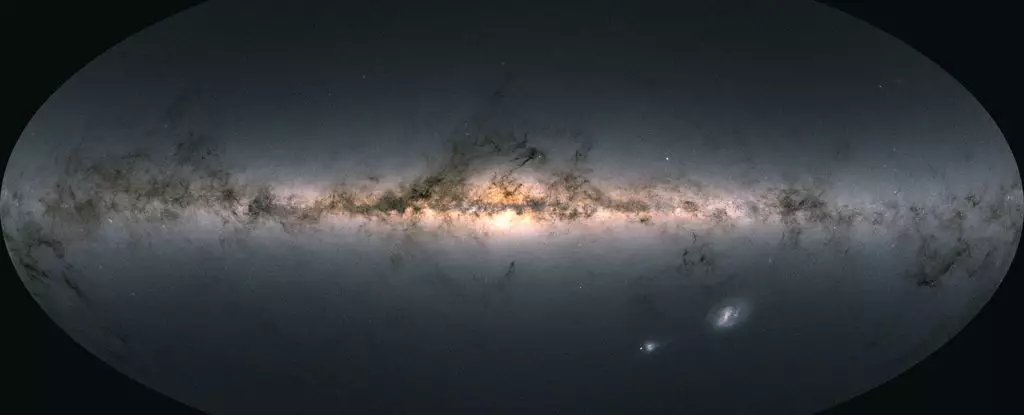Recent astronomical research has uncovered evidence suggesting that our Milky Way galaxy may be on a collision course with a supermassive black hole lurking in the Large Magellanic Cloud (LMC), a dwarf galaxy that orbits our own. This revelation poses crucial questions about cosmic dynamics and the evolutionary paths of black holes. Led by Jiwon Jesse Han of the Harvard & Smithsonian Center for Astrophysics, this ongoing inquiry has pinpointed an unseen entity boasting a staggering mass of around 600,000 solar masses. The implications of this discovery could radically reshape our understanding of how black holes evolve from smaller stellar origins to titanic entities.
The LMC, currently at a distance of approximately 160,000 light-years, represents not just a nearby galactic neighbor, but a reminder of the dynamic processes shaping our universe. With an eventual rendezvous with the Milky Way projected to occur in about 2 billion years, the potential existence of this black hole raises the stakes on how cosmic collusions can impact galactic evolution.
Identifying black holes is a complex undertaking, primarily due to their elusive nature. Unlike stars that emit light and other forms of radiation, black holes remain invisible in the dark expanses of space unless they are engaged in a ravenous feast. When matter falls towards them, it generates intense heat and light through friction, providing astronomers with a detectable signature. However, in many cases, such as the supposed black hole within the LMC, conventional methods fall short.
In this context, Han and his team employed an alternative strategy that involved observing hypervelocity stars. These astronomical phenomena are identified by their unusually high speeds, so fast that they could potentially escape the gravitational pull of their home galaxy. By analyzing the movement of these stars and their interactions with surrounding forces, astronomers can infer the existence and position of hidden gravitational giants like black holes.
Central to this research is the Hills mechanism, a phenomenon that explains how hypervelocity stars are expelled at such remarkable speeds. It postulates a three-body interaction in which a black hole interacts with two stars, causing one of them to be flung outward into deep space. This gravitational “slingshot” effect provides a fascinating lens through which to investigate the dynamic environment around potential black hole candidates.
Utilizing data from the retired Gaia space telescope, the research team meticulously reconstructed the velocities and trajectories of 21 hypervelocity stars found in the Milky Way’s outer halo. They distinctively categorized these stars and confirmed that 16 of them exhibited patterns consistent with the Hills mechanism. Remarkably, several of these stars traced their origins back to the LMC, ultimately indicating the presence of a hidden supermassive black hole contributing to these rapid ejections.
The collision of the Large Magellanic Cloud with the Milky Way will not merely be an astronomical event; it will be a significant catalyst for the growth of black holes. As the two galaxies merge over the coming billions of years, the black hole currently speculated to exist in the LMC will eventually find its way toward the Milky Way’s central supermassive black hole, known as Sagittarius A* (Sgr A*). This cosmic interaction symbolizes a critical process through which black holes can grow from smaller to larger masses, eventually forming even more colossal entities capable of influencing the structure of entire galaxies.
The merging of these black holes represents a pivotal moment in the evolutionary cycle of galaxies. Future astronomers and cosmic observers—though long after humanity’s time—may witness the dance of these titans as they coalesce into a single, more massive black hole, offering unique insight into the long-unfolding narrative of the universe.
The research led by Han is more than a catalog of astronomical curiosities; it is a gateway into understanding the mechanisms that drive the universe’s evolution. As the scientific community continues to prioritize high-resolution observations of stars and their movements, further investigations are paramount. These endeavors will seek to confirm the existence of the hypothesized black hole and unravel its properties, deepening our understanding of the intricate relationships between celestial masses.
This pivotal research not only posits a compelling theory about the existence of a black hole in the Large Magellanic Cloud but also underscores the complexity and dynamism of our universe. Future explorations into the cosmos may reveal more hidden stories waiting to be uncovered, shaping the narratives of black holes and galaxies for generations to come. As we continue to peer into the vast darkness of space, our quest for knowledge remains boundless, with every new discovery lighting the way forward.


Leave a Reply